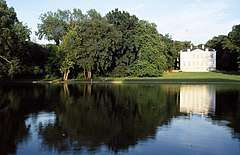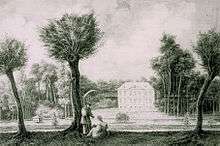Malou Park
Malou Park (French: Parc Malou, Dutch: Maloupark) is an urban park in the Woluwe-Saint-Lambert municipality of Brussels, Belgium. It is located in the valley of the Woluwe stream, to the southeast of the Woluwe Shopping Center. It is the municipality's oldest and biggest park.
| Malou Park | |
|---|---|
| Parc Malou (French) Maloupark (Dutch) | |
 The park and the Château Malou | |

| |
| Type | Public park |
| Location | Woluwe-Saint-Lambert, Brussels-Capital Region, Belgium |
| Area | 8 ha (20 acres) |
History

The park was established on the marshy, boggy field surrounding the banks of the Struybeek stream, a tributary of the Woluwe. In 1774 the park featured 7 fish ponds, a small hunting lodge called t'Speelgoet and a small reservoir. The gardens of the Speelgoet castle were laid out in the early 17th century by the hunting lodge's first known owners, a local family called Preud'homme.[1]
In 1776, the local merchant and banker Lambert de Lamberts built his château residence in the park, which was to be later renamed after Jules Malou, the most famous of its residents. The château's successive owners transformed the formal gardens to the park's present form – a landscape largely covered by trees.
The municipality acquired the park in 1951. The remains of the previously large bogs or marshy areas can still be seen behind the Lindekemale watermill.
Situation
Malou Park lies to the east of the major thoroughfare Boulevard de la Woluwe/Woluwelaan, bordered from the north by Avenue Debecker/Debeckerlaan, from the south by Chaussée Stockel/Stokkelsesteenweg and from the east by Chemin du Struybeken/Struybekenweg.
The park overlooks the valley of the Woluwe, which is a tributary of the large lake on the western side of the park. It covers some 8 hectares (20 acres) in total, including the last remaining pond, home to several ducks and swans.[2]
There are four principal recreation areas within the park:
- the walk along the banks of the brook and pond, renovated in 2001;
- the area of relaxation and culture in and around the Château Malou, with its contemporary art exhibitions;
- the botanical area with vegetable groupings such as alder trees, with ivy and lesser celandine, and a marshy alder plantation with nettles and meadowsweet;
- a playground to the east of the château featuring a pirate boat.
Prominent sights

One of the most prominent features of the park is the Château Malou, a neoclassical castle built in 1776. In 1853, the building was occupied by the Belgian politician and statesmen Jules Malou and both the château and the surrounding parkland bears his name.
On the northern side of the park stands an enormous statue of a lion.
The Lindekemale watermill is a 12th-century structure at the north side of the park, currently operating as a restaurant.
References
External links
- Parcs et Jardins de la Région Bruxelles - Capitale
- Les promenades à Woluwe-St-Lambert
- Ecole Communale Parc Malou
- Parc Malou in Google maps
| Wikimedia Commons has media related to Parc Malou. |